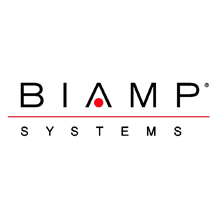 |
| At ISE 2015, Biamp will be showing an educational video on Networked Media Systems |
Biamp Systems, an award-winning professional audio system manufacturer, has unveiled an initiative aimed at emphasising the importance and advantages of Networked Media Systems (NMS). These efforts seek to fuel the conversation on how an NMS can simplify system design, streamline installation processes, and produce operational benefits for organisations.
Maximises system capabilities
Networked Media Systems are audio and/or video solutions that use an Ethernet network to share processing power and resources, in addition to transporting media. Designed to maximise system capabilities while simplifying overall administration, NMS support simultaneous applications throughout facilities — ranging from paging and conferencing to sound reinforcement requirements. As a result, customers are able to utilise existing network infrastructure as a means of delivering superior audio quality in a more economical distribution model.
“Our goal is to increase the awareness of Networked Media Systems as not just the method for connecting the parts of an AV system, but also just as much a tool to be leveraged,” shared Justin O’Connor, Audio Products Manager for Biamp Systems. “AV solutions have evolved to more IT-centric infrastructures, and there’s an increased need to provide education resources that illustrate how to leverage the full benefits of an NMS.”
Increases interoperability and improves flexibility
Facilitated by Biamp’s award-winning Tesira® and Vocia® platforms, Networked Media Systems are considered the evolution from more isolated, analogue systems. Designed as centralised, distributed, hybrid, or decentralised systems, employing an NMS approach is changing the way audio is installed by increasing interoperability, improving flexibility, and reducing the need for dedicated specialised cabling and components. As a result, audio is now able to move seamlessly between systems, endpoints can be relocated to accommodate growth, and system capabilities can be easily expanded across new areas of the enterprise.
To leverage the benefits of a Networked Media System, Biamp’s Tesira SERVER supports up to eight DSP cards per chassis and can be doubled to run as a redundant pair — carrying identical processor and card configurations. Tesira also runs both CobraNet® and Dante™ alongside AVB within a single Tesira SERVER-IO chassis, at the same time. Using Biamp’s Vocia, integrators can easily specify different zones for applications such as background music, paging, and sound reinforcement. The platform can also create a web of self-monitoring smart devices and allows for endpoints to be installed anywhere within an NMS.
At ISE 2015 in booth 1-M100, Biamp will be showing an educational video on Networked Media Systems as well as hosting presentations in multiple languages.




